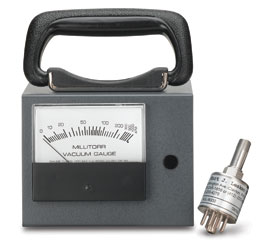Creating a complete gauging set up - What do I need?
After selecting the proper gauge for a particular application the next question is often "how do I hook it up?" What follows are some general suggestions about operating and interfacing with pressure measurement devices. Because there are many options in the gauging world and there are many different applications you'll see words like most, many, normally, typically, generally, and sometimes used a lot in this write-up. While it is difficult to make definitive statements about communicating and operating gauging these guidelines apply to most situations.
Please note - In the information that follows there is no mention of the connecting hardware that is needed to connect the gauge to the chamber itself. Normally connecting hardware is not included with the gauge and must be purchased separately.
After selecting the proper gauge type there are two basic ways to run the gauge.
1) A complete solution from KJLC. This means everything that is needed to operate, read, and communicate with the gauge is included. Typically this consists of a gauge head, a controller, and an interconnect cable.
Advantages:Disadvantages:
- Plug and Play - No additional on site work required
- Increased Functionality - Controllers can offer set points, data logging, and additional communication that can help automate and troubleshoot vacuum systems
- Sometimes a more expensive option
KJLC gauging packages - 3 examples

Many Thermocouple gauges use one part number for a full gauging package - Part number KJL-205 includes an analog display with power cord, KJL-6000 gauge tube, and a10 foot sensor cable. Similarly part number KJL615TC includes a digital vacuum gauge controller, a thermocouple gauge tube tested and calibrated with the controller, a 10 foot controller to gauge tube cable, and a 5 foot AC power supply.

The 375 Series Controller operates the 275 series gauge heads. To build a complete package the following items are required:

Some gauges, such as our 354 series Ionization Gauge, have a built in controller and display. To build a full set up with these types of gauges typically just a power supply is required. For example
2) A customer supplied data acquisition or control system. If the end user or system manufacture is already utilizing an existing data acquisition or control system - which might mean a PLC based system, a PC running LabVIEW or some other type of software, or even something as simple as a chart recorder then gauging can be integrated into this existing system. There are two possible ways that this integration maybe accomplished and the manual should be consulted to help determine the full scope of gauge integration (most manuals are available for download on the product pages for each gauge).
One method is to buy a power supply and a gauge head with integrated electronics.
Advantages:Example —Disadvantages:
- Typically more cost effective (when compared to a full gauging package)
- Eliminates unnecessary controller
- Typically no custom wiring/soldiering required
- NOT plug and play - That gauge will output some signal that is related to the pressure, how that signal is read and interpreted is up to the person integrating the gauging. This means programming is usually required
- Trouble shooting becomes more difficult when non-Lesker components is involved
- Lose of depth offered by controller
The 615TCE Ethernet enabled thermocouple gauge easily connects to any PC and includes software to monitor pressure. The 300 series Convectron® gauge has a built in com port and two relays for additional process control.
The other way to integrate gauging with existing equipment is to purchase just the gauge head from KJLC and use the pin out and wiring instructions in the manual to fabricate a custom cable. This is the most complicated method, but will also be the best option for certain customers.
Advantages:Example —Disadvantages
- More cost effective
- Eliminates unnecessary controller
- Fully integrates gauging into 'custom' control system
- Flexible - any gauge with a standard sub-D connector can be used in this fashion
- Most labor intensive method - programming and custom wiring typically involved
- Most vacuum level pressures gauges do not operate with 4-20mA current loop, a popular way to operate many devices in industrial settings.
Typically any gauge with a sub-D type connector can be utilized in this manner, and very detailed wiring and pin out data is usually available in the gauge manual. The manual can be downloaded from the specific product page of the KJLC website and should be studied carefully to gain a full understanding of what is involved when pressure measurement devices are utilized in this manner.
Additional questions? - Please feel free to contact us by clicking here .



